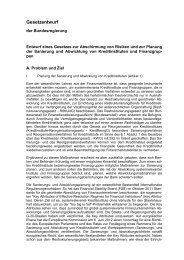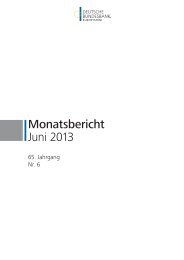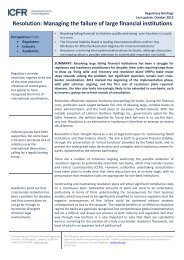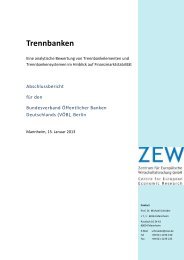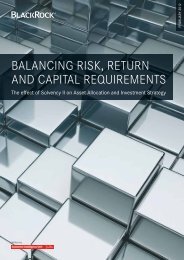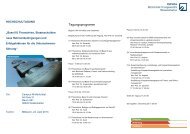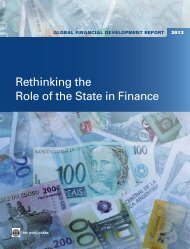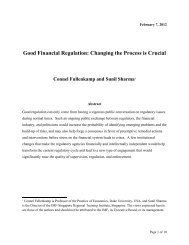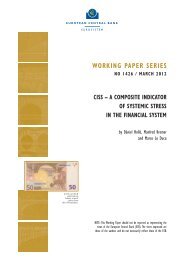3 Issuing costs of state guaranteed bonds - Financial Risk and ...
3 Issuing costs of state guaranteed bonds - Financial Risk and ...
3 Issuing costs of state guaranteed bonds - Financial Risk and ...
Create successful ePaper yourself
Turn your PDF publications into a flip-book with our unique Google optimized e-Paper software.
4 Impact <strong>of</strong> <strong>state</strong> <strong>guaranteed</strong> <strong>bonds</strong> on bank lending, funding <strong>and</strong> pr<strong>of</strong>itability performance<br />
Overall, these studies suggest the prominence <strong>of</strong> variables capturing general conditions in the<br />
banking sector <strong>and</strong> bank-specific variables, especially relating to bank capital in a model <strong>of</strong> lending.<br />
In essence, the structure <strong>of</strong> the lending model is a reduced form <strong>of</strong>:<br />
a dem<strong>and</strong> <strong>of</strong> banks loans which depends on the <strong>state</strong> <strong>of</strong> the economy <strong>and</strong> borrowing <strong>costs</strong><br />
as represented by the long-term interest rate<br />
a supply <strong>of</strong> loans which depends on the intermediation <strong>and</strong> maturity transformations<br />
margins, i.e. the difference between long-term rates <strong>and</strong> short rates representing various<br />
short-term funding sources (wholesale market, central bank) <strong>and</strong> the volume <strong>of</strong> funds<br />
available to the bank to lend out. In addition to these factors, the size <strong>of</strong> its impaired<br />
portfolio is assumed to affect negatively a bank’s willingness to lend, ceteris paribus, as<br />
the larger the impaired portfolio the greater the need to rebuild the balance sheet. This<br />
broad characterisation <strong>of</strong> the supply <strong>of</strong> loans builds on the recent emphasis in the<br />
literature <strong>of</strong> the a reformulated lending channel for the transmission <strong>of</strong> monetary policy<br />
which recognises that bank lending is not simply reacting passively the variations in<br />
deposits but is actively managed by banks which can rely on wholesale markets to meet<br />
their funding needs (see, for example Disaytat (2010)).<br />
The equation shown in the next section is simply a reduced form <strong>of</strong> these dem<strong>and</strong> <strong>and</strong> supply<br />
equation.<br />
This background motivates the inclusion <strong>of</strong> the following controls in the specification for<br />
estimating the impact <strong>of</strong> <strong>state</strong> guarantees on lending.<br />
Empirical strategy<br />
The main empirical specification considered is based on the following difference-in-differences<br />
model for participating <strong>and</strong> non-participating banks over the period 2005-2010.<br />
LENDINGit 1 GUARANTEEDit-1 2 GUARANTEE YEARit 3 BANK RATINGit 4 it-1<br />
5 jt 6 -TERM)jt 7 -TERM)jt 8 <br />
INTERBANK RATEt 9 t it-1 t t*i + vi it<br />
(7)<br />
For each bank, i, in country <strong>of</strong> risk, j, in year, t:<br />
LENDINGit is measured by net loans<br />
GUARANTEEDit-1 is whether or not the bank participated in a <strong>state</strong> guarantee scheme<br />
GUARANTEE YEARit indicates the first year in which the bank participated in a <strong>state</strong><br />
guarantee scheme<br />
BANK RATINGit is a categorical variable ranging from AAA to B+<br />
RESERVESit-1 is reserves for impaired loans as a proportion <strong>of</strong> total liabilities <strong>and</strong> equity<br />
REAL GDPit is real gross domestic product <strong>of</strong> the country<br />
INTEREST RATE (LONG-TERM)jt is the interest rate on the 10-year government bond <strong>of</strong> the<br />
Member State<br />
99



